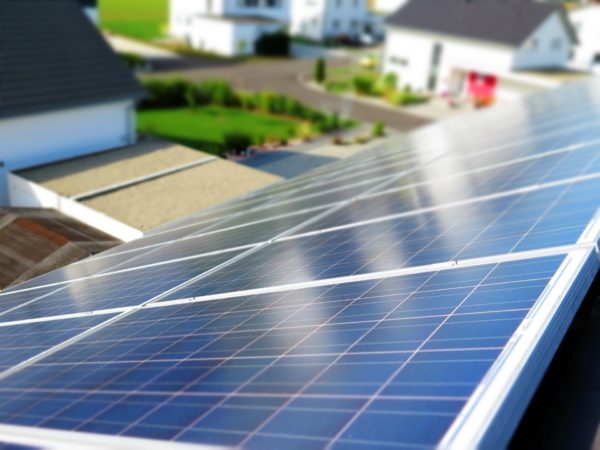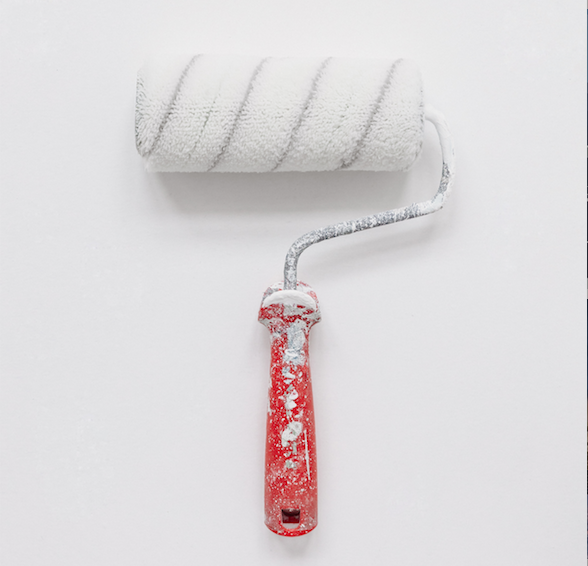Solar paint, also known as photovoltaic paint, is perhaps one of the most interesting concepts available in the solar power market. However, while it has been shown that solar paint does work as described and it’s been improved by various institutes and universities, it’s not quite a commercial product yet. This will teach you all about solar paint and how it can potentially change the future of home energy.
What is Solar Paint?

Meet the newest innovation in the realm of elegant alternative energy solutions.
While the efficiency and advantages of solar panels continue to make great strides with newer technology, there’s another solar power player on the field.
Solar paint can feel like a foreign concept, but in its simplest form, it is exactly what it sounds like. It’s a chemically-engineered paint that uses the power of the sun to gather and conduct energy into a usable form.
Solar paint is like a solar panel in some ways. Both technologies can absorb sunlight and convert it into usable energy for lights, appliances, and devices. Solar technologies can power anything that requires electricity.
The major difference between the two is how they are used. A solar panel is typically on the larger side, and it is installed on a roof or anywhere else with easy access to sunlight. There have been advances in the field of shrinking solar panels so that they are easier and cheaper to install, and currently, they can be as small as shingles. Solar paint refines the same technology into a thin layer of conductive materials that can be applied on any surface. We can now create liquid-based solar panels that can be “installed” with the swipe of a paintbrush.
The technology is still in development, but it can be applied to any surface regardless of its size or shape. The idea is to give you access to the energy of sunlight as easily as you can paint a small doghouse, roof, window, wall, solar vehicle, or entire home. This easy application makes it simple to turn any surface into a solar battery that can generate and store power.
Solar paint, or photovoltaic paint, is perhaps one of the most interesting concepts coming out of the solar power industry. It has been proven that solar paint works as described and is being constantly improved by various institutes and universities. It’s not quite ready for the commercial market yet, but it’s a fascinating technology primed to potentially change the future of home energy.
How Does Solar Paint Work

Photovoltaic paint is also referred to as quantum dots. The paint is made up of microscopic semiconductors that capture light and turn it into an electric current that can move through the paint medium for further use.
This type of paint forms a layered film that can be rolled out on a surface or installed similar to wallpaper. It can be applied to a new surface or used to renew and paint current solar panel systems. While some limitations exist, this is still much more flexible than standard solar panels.
Leading Innovations in Photovoltaic Paint Technology
There are currently several iterations of photovoltaic paint are currently available, and each one has shown promise. The Royal Melbourne Institute of Technology (RMIT) created one of the most popular versions of solar paint.
The researchers at RMIT created a type of paint that combines titanium oxide with synthetic molybdenum sulfide. The former is a common ingredient found in most paints that helps them adhere to surfaces. The second ingredient is like a silica gel that is capable of absorbing sunlight and making energy.
According to RMIT, this material is able to take in both solar energy and moisture, which is rich in hydrogen. The hydrogen will be removed from the moisture and then converted into power for fuel cells and similar products.
The University of Toronto made its own variation of solar paint. It seems to be a little more effective in generating power, but it’s not as flexible as conventional paint. They are working on adding colloidal quantum dots to a surface material. This is a common semiconductor used with computers and LEDs, so the technology is definitely effective.
These are not the only establishments working on this project, but currently, their work seems to be the most viable and advanced.
Other institutions are focused on developing other forms of solar paint that deal with water vapor, hydrogen harvesting technology, and perovskite electrical conductors. It’s a fascinating world of research and innovation.
Commercial Viability

As stated above, photovoltaic paint is still more of a concept than a product. This is because the technology isn’t quite commercially viable just yet. Most of the solar paint projects are working and are capable of generating power, but not enough for them to go into full production.
Solar panels are currently the king of solar power. They operate at an average efficiency of 18 percent, which means they can convert 18 percent of sunlight into power. That may not sound like a lot, but it translates into more than enough power for a house or business.
Photovoltaic paint, on the other hand, is only able to run at an average efficiency of three to eight percent. This isn’t enough power to justify the cost of producing this product. It can supply weaker batteries and devices with enough power, but few people would invest in it because it’s unable to power homes and larger appliances.
Most experts say that solar paint would need to reach at least 10 percent efficiency before being considered commercially viable. While it is getting close, it will likely be a few more years before this is sold as a product.
The Future Is Bright with Solar Paint
Solar paint is a futuristic concept that is quickly becoming a commercially viable product. While it will likely be a few more years before it goes into full-scale production, you can expect to see this being used on homes both large and small in the near future. Not only is this paint easier to apply than solar panels, but it can be used in every environment and on any structure.

Frequently Asked Questions
Who created solar paint?
Solar paint is an invention of researchers from the Royal Melbourne Institute of Technology (RMIT).
What are the advantages of solar paint?
As solar paint technology develops, it should become cost-effective, better for the environment, efficient, and flexible in its applications and uses.
What are the disadvantages of solar paint?
Current solar paint configurations aren’t as efficient at capturing energy as normal solar panels. Some contain lead as a conducting unit or pose other environmental concerns. They also lack the longevity needed for economical, long-term uses.
Is solar paint good for the environment?
Depending on the basic components and type of energy conduction, solar paint does have the potential to be good for the environment. It’s a promising solution that gets better every day.
Is solar paint commercially available?
Not yet, but it’s a rising star you’ll want to watch. We could see the first products commercially available as soon as 2029.





